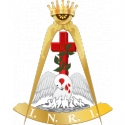The ‘Rose Croix’ Degree is the 18th of a series of 33 degrees, originating in France and which in 1801 were formed into the Ancient and Accepted Scottish Rite of Freemasonry. When these degrees were developed in the 18th century, their members were Christian even though many of their themes, as in Craft Masonry, dealt with the pre-Christian era and had no connection with Christianity. Since 1801 some Supreme Councils have reverted to the universality of Craft Masonry and allow members of all religions to join. The Supreme Council 33º for England and Wales and its Districts and Chapters Overseas within its jurisdiction and which controls the Ancient and Accepted Rite ( “A & A R”) (the word Scottish did not appear in its patent) have now considered the time has come to follow that ruling. Therefore from 1st March 2024 members will not be required to sign the Petition of Allegiance to the Trinitarian Christian faith. This will in turn require some amendments to the current ritual.
The Rose Croix ceremony (the ceremony of Perfection) is the only ceremony which can be worked in full by a Chapter. The first three degrees of Craft Masonry are accepted by The Supreme Council for England and Wales as the equivalents of the first three degrees of the A & A R and the intervening degrees from the 4º to the 17º (known as the Intermediate Degrees) are conferred by name. The first 18º ritual originated with a Frenchman named Willermoz and is dated 1765. It has a wholly New Testament theme and is influenced by the legends of the descendants of the builders of the Temple at Jerusalem taking refuge in a mountain in Scotland called Heredom. When the Crusades began the posterity of the masons joined the Crusades but on their return from the Holy Land dispersed and spread Masonry throughout the world. Several of the degrees of the A & A Rite include parts of this story.
The Rose Croix degree is first recorded in England in about 1770. The Knights Templar degrees, also Christian, were starting in England at about the same time and eventually the Rose Croix degree took its place as the final or ne plus ultra degree of the English Knights Templar encampments. After 1845 however Rose Croix Chapters gradually moved to their present position as the 18º of the A & A R.
The ceremony, which seeks the Perfection of Christian virtues in Faith, Hope and Charity, is an immensely thought provoking, impressive and beautiful ceremony which instils a warmth of Brotherly love on which the whole Masonic movement is founded.
All degrees of the Rite from 4º – 33º are the entire responsibility of the Supreme Council. They were developed during the period 1730-1801; the majority before 1780. The 4º – 13º may be considered as extensions of the Master Masons legend referring to the completion of the Temple at Jerusalem under King Solomon’s direction. The 14º – 16º refer to the rebuilding of the Temple and were developed in France at about the same time and used the same material as the Royal Arch degree in England. The 17º is a mystical preparation for the 18º.
Between 1760 and 1780 the basic rituals of the 18º-25º were completed. Some are entirely Christian and most have some references to Christianity. Under the authority of the Grand Constitutions of 1786 the degrees were expanded to 33 to form the Ancient and Accepted Scottish Rite with the formation of the American Supreme Council of the Scottish Rite in Charleston, USA , in 1801.
